Dr. Adam Freund PhD., Calico Life Sciences, Discussing Google Quest to Solve Aging.
Ira Pastor, ideaXme life sciences ambassador interviews Dr Adam Freund, PhD, Principal Investigator at Calico Life Sciences (Calico). https://www.calicolabs.com
Ira Pastor comments:
Calico is a research and development focused biotechnology company founded and backed by Google / Alphabet with the goal of combating aging and associated age-related diseases.
Calico has a billion dollar partnership with the bio-pharma giant AbbVie, focused on aging and age-related diseases, such as neuro-degeneration and cancer. Calico also has partnerships with the University of Texas Southwestern Medical Center and 2M Companies (regarding drug development for neurodegenerative disorders), the Broad Institute of MIT and Harvard (to advance research on age-related diseases and therapeutics), and a partnership with the Buck Institute for Research on Aging.
Calico has also announced a partnership with the California Institute for Quantitative Biosciences (QB3) based on researching the biology of aging and identifying potential therapeutics for age-related diseases, as well as and one with Ancestry-DNA based on conducting research into the genetics of human lifespan.
Dr. Adam Freund, Ph.D., is a Principal Investigator at Calico Life Sciences studying aging on the systems biology level.
With a Ph.D. in Molecular and Cell Biology, from the University of California at Berkeley, and a B.S. in Materials Science and Engineering from Stanford University, Dr. Freund’s lab works to identify and test post-developmental interventions that slow or reverse aspects of aging, as well as understand whether aging is regulated by similar mechanisms in diverse tissue compartments. To accomplish these goals, his lab develops automated, high content methods to quantify longitudinal decline and build tools to modulate targets with spatial and temporal precision in preclinical models, including gene delivery as well as small and large molecules. They use these tools to test hypotheses of aging in rapid, functionally relevant ways.








